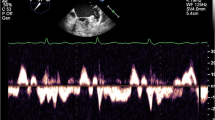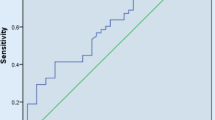Abstract
Background
Atrial fibrillation (AF) is the most common cardiac arrhythmia reducing the health-related quality of life. Radiofrequency catheter ablation (CA) became the therapy of choice in patients with drug-resistant AF with success rates between 30% and 86%. However, CA remains a challenging intervention with major complications in about 5% of cases. Therefore, stratification into high and low success patient groups would be helpful. The aim of this study was to investigate the predictive value of B-type natriuretic peptide (BNP) on the outcome of pulmonary vein isolation (PVI) in patients with paroxysmal (PAF) and persistent (Pers-AF) atrial fibrillation.
Materials and methods
In 73 patients (median age 53 years, 77% men) undergoing PVI for drug-refractory PAF (n = 45) or Pers-AF (n = 28), the serum BNP concentration was measured before and 3 months after the ablation procedure to assess any association of pre- and post-interventional BNP concentrations with therapeutic outcome. The patients had suffered from AF for a median of 40 months. No patient had structural heart disease or an impaired left-ventricular ejection fraction.
Results
A total of 54 patients (74%) had stable sinus rhythm 3 months after PVI. The median baseline BNP levels in both PAF and Pers-AF patients were significantly lower in patients with a 3-month successful PVI than those in which it was unsuccessful, 57.5 pg/ml (20.4–87.9) versus 159.0 pg/ml (124.1–177.5; p = 0.001) in PAF patients and 90.3 pg/ml (41.0–155.0) versus 176 pg/ml (89.6–297.4; p = 0.026) in patients with Pers-AF, respectively. A multiple logistic regression analysis identified pre-interventional BNP levels as the only independent predictor for 3-month PVI outcomes (p = 0.010). Nevertheless, in this study, the predictive value of BNP for PVI outcomes was not high enough to permit individual outcome prediction.
After successful PVI, BNP levels were significantly lower in patients with PAF and Pers-AF (median changes −16.9 and −23.8 pg/ml; p = 0.010 and p = 0.022, respectively), but not in patients with AF in follow-up (median change 9.0 pg/ml and −29.6 pg/ml; p = 1.000 and p = 0.109, respectively).
Conclusion
Pre-ablation BNP level seems to be an independent marker for successful PVI procedures in patients with paroxysmal and persistent AF; however, the observed level of association is moderate.


Similar content being viewed by others
References
Calkins, H., Brugada, J., Packer, D. L., Cappato, R., Chen, S. A., Crijns, H. J. G., et al. (2007). HRS/EHRA/ECAS expert consensus statement on catheter and surgical ablation of atrial fibrillation: recommendations for personnel, policy, procedures and follow-up. Europace, 9(6), 335–379.
Aronow, W. S. (2008). Etiology, pathophysiology, and treatment of atrial fibrillation—part 1. Cardiology in Review, 16(4), 181–188.
Wolf, P. A., Benjamin, E. J., Belanger, A. J., Kannel, W. B., Levy, D., & D'Agostino, R. B. (1996). Secular trends in the prevalence of atrial fibrillation: the Framingham Study. American Heart Journal, 131(4), 790–795.
Nattel, S. (2002). New ideas about atrial fibrillation 50 years on. Nature, 415(6868), 219–226.
Jaïs, P., Haïssaguerre, M., Shah, D. C., Chouairi, S., Gencel, L., Hocini, M., et al. (1997). A focal source of atrial fibrillation treated by discrete radiofrequency ablation. Circulation, 95(3), 572–576.
Haïssaguerre, M., Jaïs, P., Shah, D. C., Takahashi, A., Hocini, M., Quiniou, G., et al. (1998). Spontaneous initiation of atrial fibrillation by ectopic beats originating in the pulmonary veins. The New England Journal of Medicine, 339(10), 659–666.
Benjamin, E. J., Wolf, P. A., D'Agostino, R. B., Silbershatz, H., Kannel, W. B., & Levy, D. (1998). Impact of atrial fibrillation on the risk of death: the Framingham Heart Study. Circulation, 98(10), 946–952.
Thrall, G., Lane, D., Carroll, D., & Lip, G. Y. (2006). Quality of life in patients with atrial fibrillation: a systematic review. American Journal of Medicine, 119(5), 448.e1–448.19.
Horlitz, M., Schley, P., Shin, D. I., Ghouzi, A., Müller, M., Sause, A., et al. (2004). Circumferential pulmonary vein ablation for treatment of atrial fibrillation using an irrigated-tip catheter. The American Journal of Cardiology, 94(7), 945–947.
Matsuo, S., Lellouche, N., Wright, M., Knecht, S., Nault, I., Lim, K. T., et al. (2009). Clinical predictors of termination and clinical outcome of catheter ablation for persistent atrial fibrillation. Journal of the American College of Cardiology, 54(9), 788–795.
Chen, S. A., Hsieh, M. H., Tai, C. T., Tsai, C. F., Prakash, V. S., Yu, W. C., et al. (1999). Initiation of atrial fibrillation by ectopic beats originating from the pulmonary veins: electrophysiological characteristics, pharmacological responses, and effects of radiofrequency ablation. Circulation, 100(18), 1879–1886.
Cappato, R., Calkins, H., Chen, S. A., Davies, W., Iesaka, Y., Kalman, J., et al. (2010). Updated worldwide survey on the methods, efficacy, and safety of catheter ablation for human atrial fibrillation. Circulation. Arrhythmia and Electrophysiology, 3(1), 32–38.
Calkins, H., Reynolds, M. R., Spector, P., Sondhi, M., Xu, Y., Martin, A., et al. (2009). Treatment of atrial fibrillation with antiarrhythmic drugs or radiofrequency ablation: two systematic literature reviews and meta-analyses. Circulation. Arrhythmia and Electrophysiology, 2(4), 349–361.
Wozakowska-Kaplon, B., Opolski, G., Herman, Z., & Kosior, D. (2008). Natriuretic peptides in patients with atrial fibrillation. Cardiology Journal, 15(6), 525–529.
Silvet, H., Young-Xu, Y., Walleigh, D., & Ravid, S. (2003). Brain natriuretic peptide is elevated in outpatients with atrial fibrillation. The American Journal of Cardiology, 92(9), 1124–1127.
Yamada, T., Murakami, Y., Okada, T., Yoshida, N., Toyama, J., Yoshida, Y., et al. (2007). Plasma brain natriuretic peptide level after radiofrequency catheter ablation of paroxysmal, persistent, and permanent atrial fibrillation. Europace, 9(9), 770–774.
Date, T., Yamane, T., Inada, K., Matsuo, S., Miyanaga, S., Sugimoto, K., et al. (2006). Plasma brain natriuretic peptide concentrations in patients undergoing pulmonary vein isolation. Heart, 92(11), 1623–1627.
Shin, D. I., Deneke, T., Gorr, E., Anders, H., Buenz, K., Paesler, M., et al. (2009). Predicting successful pulmonary vein isolation in patients with atrial fibrillation by brain natriuretic peptide plasma levels. Indian Pacing and Electrophysiology Journal, 9(5), 241–246.
Tzou, W. S., Marchlinski, F. E., Zado, E. S., Lin, D., Dixit, S., Callans, D. J., et al. (2010). Long term outcome after successful catheter ablation of atrial fibrillation. Circulation. Arrhythmia and Electrophysiology, 3(3), 237–242.
Mainigi, S. K., Sauer, W. H., Cooper, J. M., Dixit, S., Gerstenfeld, E. P., Callans, D. J., et al. (2007). Incidence and predictors of very late recurrence of atrial fibrillation after ablation. Journal of Cardiovascular Electrophysiology, 18(1), 69–74.
Oral, H., Knight, B. P., Tada, H., Özaydin, M., Chugh, A., Hassan, S., et al. (2002). Pulmonary vein isolation for paroxysmal and persistent atrial fibrillation. Circulation, 105(9), 1077–1081.
Hof, I., Chilukuri, K., Arbab-Zadeh, A., Scherr, D., Dalal, D., Nazarian, S., et al. (2009). Does left atrial volume and pulmonary venous anatomy predict the outcome of catheter ablation of atrial fibrillation? Journal of Cardiovascular Electrophysiology, 20(9), 1005–1010.
Lee, S. H., Tai, C. T., Hsieh, M. H., Tsai, C. F., Lin, Y. K., Tsao, H. M., et al. (2004). Predictors of early and late recurrence of atrial fibrillation after catheter ablation of paroxysmal atrial fibrillation. Journal of Interventional Cardiac Electrophysiology, 10(3), 221–226.
Shah, A. N., Mittal, S., Sichrovsky, T. C., Cotiga, D., Arshad, A., Maleki, K., et al. (2008). Long-term outcome following successful pulmonary vein isolation: pattern and prediction of very late recurrence. Journal of Cardiovascular Electrophysiology, 19(7), 661–667.
Jiang, H., Lu, Z., Lei, H., Zhao, D., Yang, B., & Huang, C. (2006). Predictors of early recurrence and delayed cure after segmental pulmonary vein isolation for paroxysmal atrial fibrillation without structural heart disease. Journal of Interventional Cardiac Electrophysiology, 15(3), 157–163.
Wang, T. J., Larson, M. G., Levy, D., Leip, E. P., Benjamin, E. J., Wilson, P. W., et al. (2002). Impact of age and sex on plasma natriuretic peptide levels in healthy adults. The American Journal of Cardiology, 90(3), 254–258.
Wang, T. J., Larson, M. G., Levy, D., Benjamin, E. J., Leip, E. P., Wilson, P. W., et al. (2004). Impact of obesity on plasma natriuretic peptide levels. Circulation, 109(5), 594–600.
Redfield, M. M., Rodeheffer, R. J., Jacobsen, S. J., Mahoney, D. W., Bailey, K. R., & Burnett, J. C. (2002). Plasma brain natriuretic peptide concentration: impact of age and gender. Journal of the American College of Cardiology, 40(5), 976–981.
Goetze, J. P., Friis-Hansen, L., Rehfeld, J. F., Nilsson, B., & Svendsen, J. H. (2006). Atrial secretion of B-type natriuretic peptide. European Heart Journal, 27(14), 1648–1650.
McKie, P. M., & Burnett, J. C. (2005). B-type natriuretic peptide as a biomarker beyond heart failure: speculations and opportunities. Mayo Clinic Proceeding, 80(8), 1029–1036.
Yamada, T., Murakami, Y., Okada, T., Okamoto, M., Shimizu, T., Toyama, J., et al. (2006). Plasma atrial natriuretic peptide and brain natriuretic peptide levels after radiofrequency catheter ablation of atrial fibrillation. The American Journal of Cardiology, 97(12), 1741–1744.
Kurosaki, K., Tada, H., Hashimoto, T., Ito, S., Miyaji, K., Naito, S., et al. (2007). Plasma natriuretic peptide concentrations as a predictor for successful catheter ablation in patients with drug-refractory atrial fibrillation. Circulation, 71(3), 313–320.
Lellouche, N., Berthier, R., Mekontso-Dessap, A., Braconnier, F., Monin, J. L., Duval, A. M., et al. (2005). Usefulness of plasma B-type natriuretic peptide in predicting recurrence of atrial fibrillation one year after external cardioversion. The American Journal of Cardiology, 95(11), 1380–1382.
Nilsson, B., Goetze, J. P., Chen, X., Pehrson, S., & Svendsen, J. H. (2009). Increased NT-pro-B-type natriuretic peptide independently predicts outcome following catheter ablation of atrial fibrillation. Scandinavian Journal of Clinical and Laboratory Investigation, 69(8), 843–850.
Kim, B. J., Hwang, S. J., Sung, K. C., Kim, B. S., Kang, J. H., Lee, M. H., et al. (2007). Assessment of factors affecting plasma BNP levels in patients with chronic atrial fibrillation and preserved left ventricular systolic function. International Journal of Cardiology, 118(2), 145–150.
Müller, H., Noble, S., Keller, P. F., Sigaud, P., Gentil, P., Lerch, R., et al. (2008). Biatrial anatomical reverse remodelling after radiofrequency catheter ablation for atrial fibrillation: evidence from real-time three-dimensional echocardiography. Europace, 10(9), 1073–1078.
Bakowski, D., Wozakowska-Kaplon, B., & Opolski, G. (2009). The influence of left ventricle diastolic function on natriuretic peptides levels in patients with atrial fibrillation. Pace, 32(6), 745–752.
Lubien, E., DeMaria, A., Krishnaswamy, P., Clopton, P., Koon, J., Kazanegra, R., et al. (2002). Utility of B-natriuretic peptide in detecting diastolic dysfunction: comparison with Doppler velocity recordings. Circulation, 105, 595–601.
Bolt, C. L., Baur, L., Stoffers, J., Lenderink, T., & Winkens, R. (2009). Novel strategies for the detection of systolic and diastolic heart failure. Current Cardiology Reviews, 5(2), 112–118.
Author information
Authors and Affiliations
Corresponding author
Rights and permissions
About this article
Cite this article
Degener, S., Pattberg, S.V., Feuersenger, H. et al. Predictive value of B-type natriuretic peptide levels in patients with paroxysmal and persistent atrial fibrillation undergoing pulmonary vein isolation. J Interv Card Electrophysiol 30, 217–225 (2011). https://doi.org/10.1007/s10840-010-9540-2
Received:
Accepted:
Published:
Issue Date:
DOI: https://doi.org/10.1007/s10840-010-9540-2




